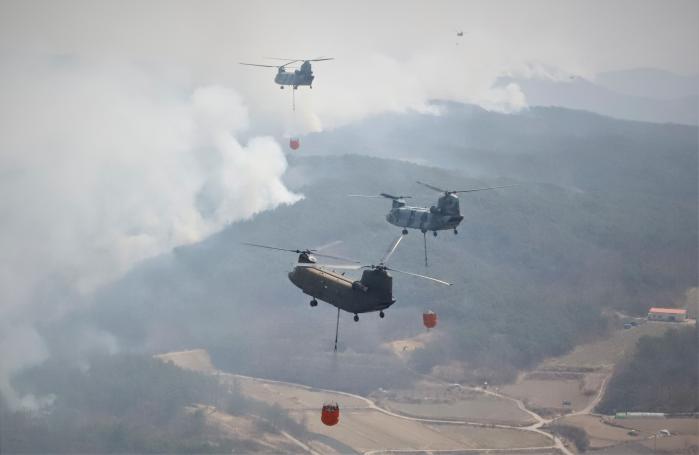
The ROK military has become a much-needed source of relief for South Korea’s wildfire-ravaged mountains. Though Thursday’s rainfall was insufficient to extinguish the flames fully, it helped calm the heat, and the soldiers’ efforts have played a major role in halting the spread.
On Thursday, the ROK Ministry of National Defense announced that it had deployed 990 additional personnel and 49 helicopters (including four from U.S. Forces Korea) to fight wildfires in Ulsan, North Gyeongsang, and South Gyeongsang Provinces. Since the outbreak of the fires, around 7,000 troops and approximately 290 military helicopters have been mobilized.
The ROK military continues to maintain combat readiness while prioritizing troop safety and supporting the firefighting efforts led by the Korea Forest Service and fire authorities. Military personnel have mainly been tasked with extinguishing residual embers and meticulously eliminating even the smallest fire sources. After missions, soldiers are checked for smoke inhalation and guaranteed adequate rest.
Military helicopters have sprayed water from the skies to suppress the flames. U.S. Forces Korea contributed four helicopters, including the CH-47 Chinook and UH-60 Black Hawk. The ROK Navy’s Aviation Command deployed a UH-60 maritime transport helicopter to conduct aerial reconnaissance in response to the wildfire’s spread in Pohang, sharing real-time data with local authorities.
The military has also provided medical aid and relief supplies, such as blankets and combat rations, to wildfire victims. In addition, aviation fuel was supplied to helicopters operated by other agencies, such as the Korea Forest Service and Fire Agency.
The wildfire, now in its sixth day and centered around the Gyeongsang region, is expected to become one of the worst in history. Due to strong winds, the fire is spreading rapidly, making it difficult to predict when full containment will be achieved.
According to the Central Disaster and Safety Countermeasures Headquarters (CDSCH), as of 4 p.m. Thursday, the human toll stood at 27 dead and 32 injured.
South Korea’s Ministry of the Interior and Safety designated Andong, Cheongsong, Yeongyang, and Yeongdeok in North Gyeongsang Province as special disaster zones on Thursday, adding to previous designations: Sancheong in South Gyeongsang Province (March 22), Ulju in Ulsan, Uiseong in North Gyeongsang, and Hadong in South Gyeongsang (March 23).
Acting President and Prime Minister Han Duck Soo stated, “Given the considerable damage to residential infrastructure as well as the tragic loss of life, we will spare no administrative and financial support to facilitate swift recovery efforts. We will prioritize addressing the inconveniences displaced residents face and do our utmost to help them return to normal life as soon as possible.”














Comments0